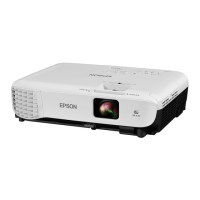
Do you have a question about the Epson VS250 and is the answer not in the manual?
| Matrix type | 3-panel (p-Si TFT active) |
|---|---|
| Number of colors | 1.073 billion colors |
| Native aspect ratio | 4:3 |
| Projection distance | 0.88 - 10.44 m |
| Projection technology | 3LCD |
| Contrast ratio (typical) | 15000:1 |
| Screen size compatibility | 30 - 350 \ |
| Projector native resolution | SVGA (800x600) |
| Keystone correction, vertical | -30 - 30 ° |
| Noise level | 37 dB |
| Projection modes | Ceiling, Front, Rear |
| Password protection | Yes |
| Noise level (economic mode) | 28 dB |
| Placement | Desktop |
| Product type | Standard throw projector |
| Product color | White |
| 3D | No |
| Full HD | - |
| Analog signal format system | NTSC, NTSC 4.43, PAL, PAL 60, PAL M, PAL N, SECAM |
| Supported graphics resolutions | 1024 x 768 (XGA), 1152 x 864 (XGA+), 1280 x 1024 (SXGA), 1280 x 800 (WXGA), 1280 x 960, 1400 x 1050 (SXGA+), 1440 x 900 (WXGA+) |
| Lamp type | UHE |
| Lamp power | 210 W |
| Lamps quantity | 1 lamp(s) |
| Light source type | Lamp |
| Lamp power (economic mode) | - W |
| Service life of light source | 6000 h |
| Service life of light source (economic mode) | 10000 h |
| Focus | Manual |
| Throw ratio | 1.45 - 1.96:1 |
| Digital zoom | 1.35 x |
| Fixed focal length | 16.7 mm |
| Focal length range | - mm |
| Aperture range (F-F) | 1.44 - 1.44 |
| Operating temperature (T-T) | 5 - 35 °C |
| HDMI connector type | Full-size |
| USB 2.0 ports quantity | USB 2.0 ports have a data transmission speed of 480 Mbps, and are backwards compatible with USB 1.1 ports. You can connect all kinds of peripheral devices to them. |
| Component video (YPbPr/YCbCr) in | 0 |
| RMS rated power | 2 W |
| Power source | AC |
| AC input voltage | 100 - 240 V |
| AC input frequency | 50 - 60 Hz |
| Power consumption (typical) | 296 W |
| Power consumption (economy mode) | 211 W |
| Depth | 125 mm |
|---|---|
| Width | 377 mm |
| Height | 291.5 mm |
| Weight | 4600 g |
Highlights key features like brightness, resolution, and connectivity options.
Guidelines for positioning the projector for optimal viewing and ventilation.
Instructions for connecting various input sources like computers and video devices.
Connects the projector to a network for wireless projection capabilities.
Adjusts focus, size, and shape for optimal image display.
Addresses issues with image quality, no image, "no signal", and audio problems.
Solves problems with projector power, remote control, passwords, and network connectivity.
Essential safety warnings, precautions, and guidelines for operating the projector.